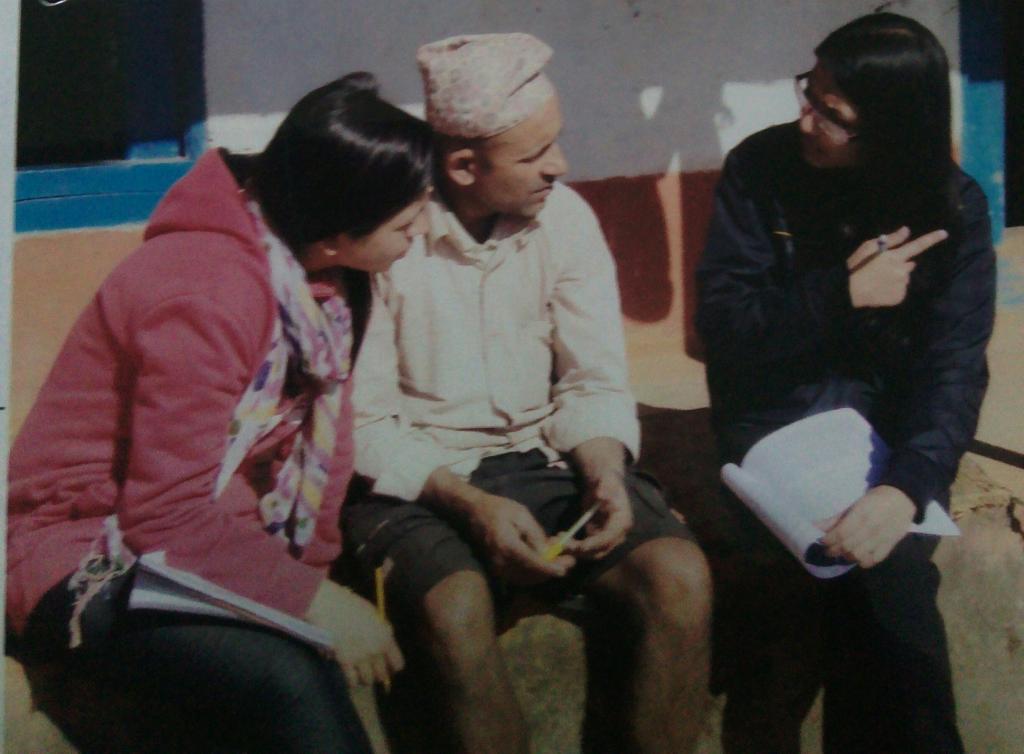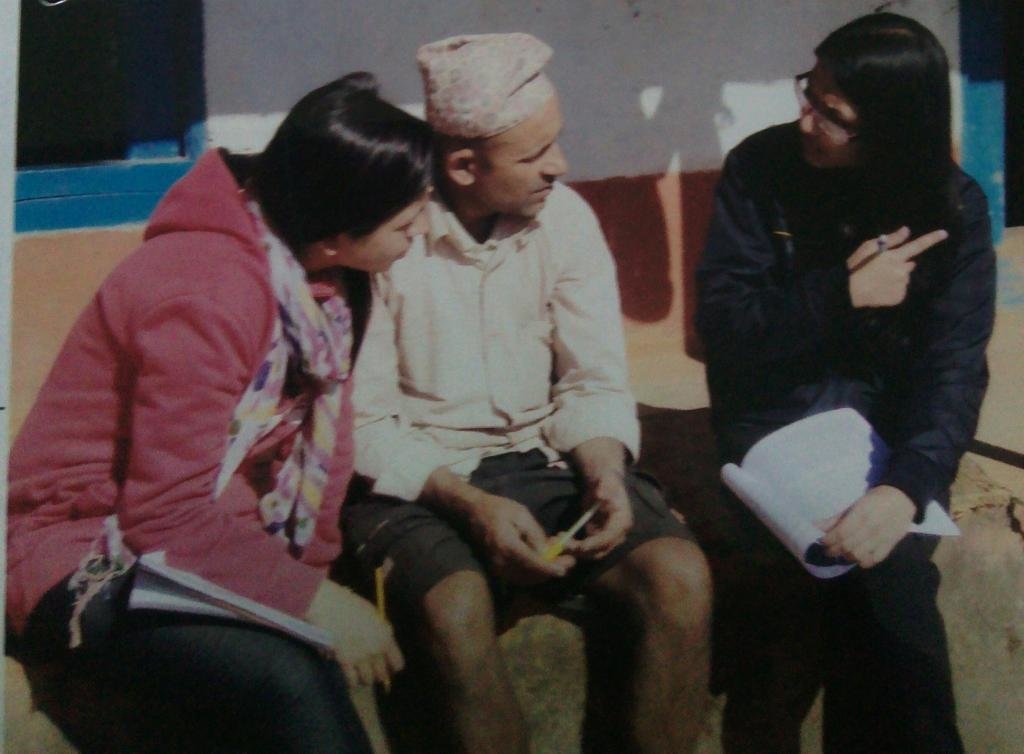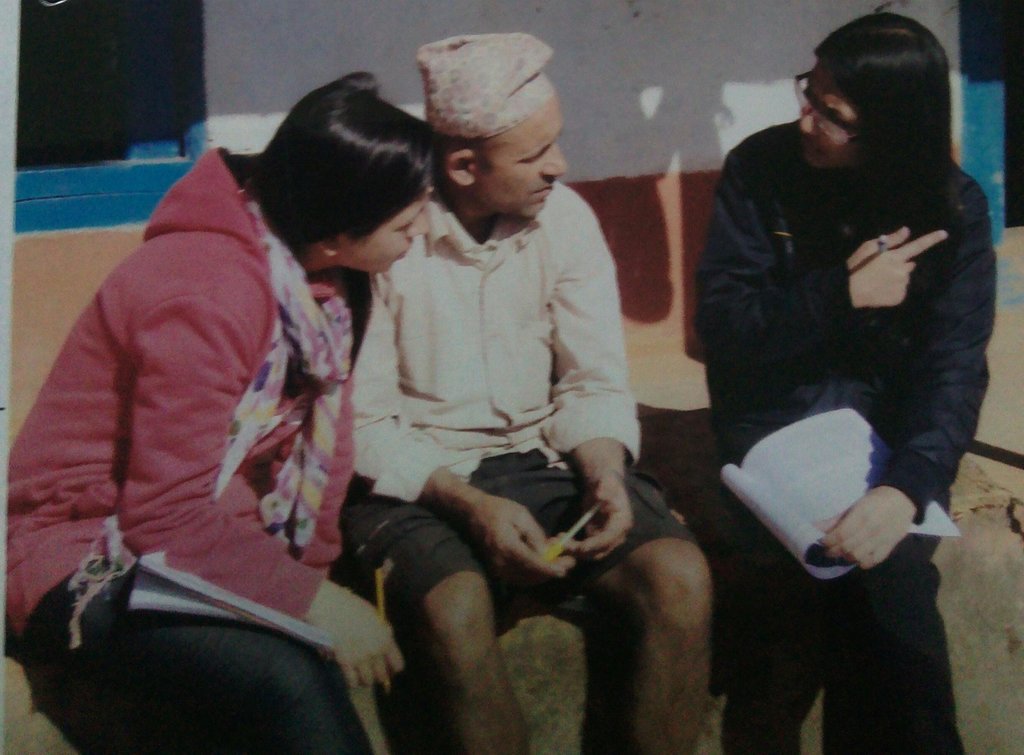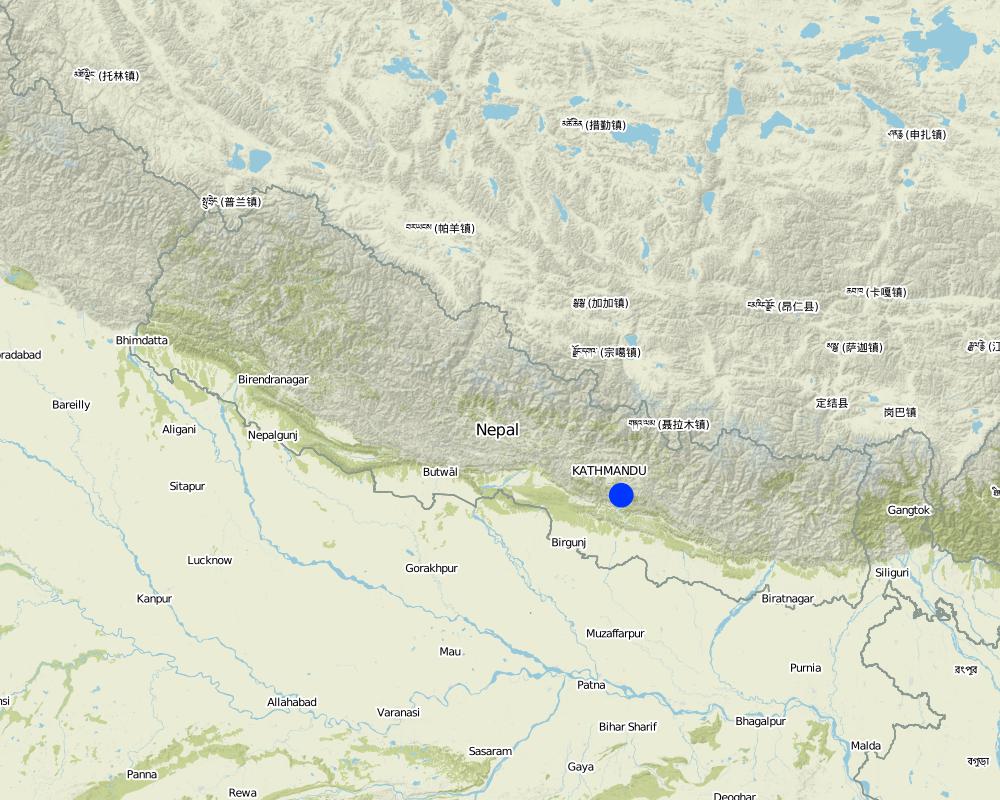Chyamrangbesi - A smoke free zone by using improved cooling stove [尼泊尔]
- 创建:
- 更新:
- 编制者: Sabita Aryal
- 编辑者: –
- 审查者: Fabian Ottiger
Chyamrangbesi- Dhuwa Muta Chhetra
approaches_2592 - 尼泊尔
查看章节
全部展开 全部收起1. 一般信息
1.2 参与方法评估和文件编制的资源人员和机构的联系方式
有助于对方法进行记录/评估的机构名称(如相关)
Kathmandu University (KU) - 尼泊尔有助于对方法进行记录/评估的机构名称(如相关)
Sarada Batase Village Development Committee (Sarada Batase VDC) - 尼泊尔1.3 关于使用通过WOCAT记录的数据的条件
(现场)数据是什么时候汇编的?:
18/01/2014
编制者和关键资源人员接受有关使用通过WOCAT记录数据的条件。:
是
1.4 SLM技术问卷的参考
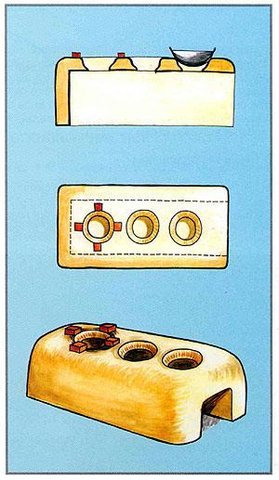
Khuwa making by the use of Improved stove [尼泊尔]
The technology used is improved stove. An improved stove is a device that is designed to consume less fuel and save cooking time,convenient in cooking process and creates smokeless environment or reduction in volume of smoke against the traditional stove.
- 编制者: Sabita Aryal

Improved Stove for household cooking use [尼泊尔]
The technoloigy is engineered in such a way that there will be less consumption of wood and less emission of smoke.
- 编制者: Sabita Aryal
2. SLM方法的描述
2.1 该方法的简要说明
The ways and means used to promote and implement to improved stove to improve human well-being and sustainable land use.
2.2 该方法的详细说明
该方法的详细说明:
Aims / objectives: The main objectives of the approach was to conserve forest and to improve human well-being
villagers facing major health risks due to smoke like eye itchiness, allergies, bronchitis.
Methods: The idea was proposed by REMRIC Nepal and was supported by Nepal Government. The approach was further enhanced by VDC and few local committes, public participation was an important part of the approach.
Stages of implementation: 1. Research : Questionnaires asked to land users and thier viewpoints noted.
2. Training : REMRIC provided trainiing to 9 people within the village
3. Financial support : Funding provided by VDC, REMRIC and other local bodies. Technician provided.
Role of stakeholders: Private contribution was not made. Organizations provided full financial funding and trained people. Involved organizations also did the research work and training people. A part from this, public participation had the significant role.
2.3 该方法的照片
2.5 采用该方法的国家/地区/地点
国家:
尼泊尔
有关地点的进一步说明:
Kavrepalanchok
Map
×2.6 该方法的开始和终止日期
注明开始年份:
2069
终止年份(若不再采用该方法):
2069
2.7 方法的类型
- 基于项目/方案
2.8 该方法的主要目的/目标
The Approach focused mainly on SLM with other activities (Forest Production, Manure for agriculture, Improved human health, Kitchen efficiency)
The main objectives of the approach were to improve health hazards caused by the smoke trapped int he room and for forst conservation.
The SLM Approach addressed the following problems: 1. Lack of technical knowledge
2. Lack of cash to invest in SLM
2.9 推动或妨碍实施本办法所适用的技术的条件
财务资源和服务的可用性/可得性
- 阻碍
Land user not ready to invest in experimental technology.
Treatment through the SLM Approach: Local bodies, organization, VDC funded the whole project.
了解SLM,获得技术支持
- 阻碍
Dur to lack of technical knowledge and information
Treatment through the SLM Approach: REMRIC tarined 9 people; each from one ward
工作量、人力资源可用性
- 阻碍
Soil, brick, rods needed to carry from sometimes far distant areas.
Treatment through the SLM Approach: Land users volunteered to carry items themselves
3. 相关利益相关者的参与和角色
3.1 该方法涉及的利益相关者及其职责
- 当地土地使用者/当地社区
Jyotisahakari, Nawa prativa, Chakreshwor, Siddhartha
Community involvement. As physical activities are more involved, men are majorly involved. 33% only women involved
- SLM专家/农业顾问
REMRIC
- 地方政府
Chyamrangbesi VDC
- 国家政府(规划者、决策者)
Nepal government
- 国际组织
3.2 当地土地使用者/当地社区参与该方法的不同阶段
| 当地土地使用者/当地社区的参与 | 指定参与人员并描述活动 | |
|---|---|---|
| 启动/动机 | 互动 | Public meetings, research questionnaires |
| 计划 | 互动 | Interviews, public meetings |
| 实施 | 自我动员 | responsibility of major and minor steps, casuale labor |
| 监测/评估 | 互动 | Measurements/observations, interviews/questionnaires |
| Research | 被动 | Answer questionnaires, informed about SLM technology, but do not take the final decision. |
3.4 有关SLM技术选择的决策
具体说明谁有权决定选择要实施的技术:
- 主要是SLM专家,咨询土地使用者之后
解释:
Initiations of approach by REMRIC and later involvement of local bodies and active involvement of VDC. However, research done actively and consulted land users about family size, thier input was considered valuable.
Decisions on the method of implementing the SLM Technology were made by mainly by SLM specialists with consultation of land users. The implementation was made by mutual agreement between the SLM specialists and the land users. However, the funding was solely done by SLM specialists.
4. 技术支持、能力建设和知识管理
4.1 能力建设/培训
是否为土地使用者/其他利益相关者提供培训?:
是
明确受训人员:
- 土地使用者
如果相关,请说明性别、年龄、地位、种族等。:
Male, 25-35 years of age
培训形式:
- 农民对农民
- 示范区域
- 公开会议
涵盖的主题:
Interviews/questionnaires, setup, construct and design technology
4.2 咨询服务
土地使用者有权使用咨询服务吗?:
是
说明/注释:
Name of method used for advisory service: VDC; Key elements: Structure, Cost; But people have ample technical knowledge, also take advice from neighbours
Advisory service is inadequate to ensure the continuation of land conservation activities; Not that hard or costly to manage the technology. So, self sustaining is sufficient for continuation of technology.
4.3 机构强化(组织发展)
是否通过这种方法建立或加强了机构?:
- 否
4.4 监测和评估
监测和评估是该方法的一部分吗?:
是
注释:
bio-physical aspects were ad hoc monitored by project staff through measurements; indicators: VDC, Trainees
area treated aspects were ad hoc monitored by project staff through observations; indicators: None
There were few changes in the Approach as a result of monitoring and evaluation: Once a year, REMERIC visits and monitors give suggestions.
There were no changes in the Technology as a result of monitoring and evaluation: Land user self-maintenance
4.5 研究
研究是该方法的一部分吗?
是
明确话题:
- 技术
提供进一步的细节,并指出是谁做的研究:
how many family members in each house
Research was carried out both on station and on-farm
5. 融资和外部物质支持
5.1 该方法中SLM组成部分的年度预算
如果不知道准确的年度预算,请给出一个范围:
- < 2,000
注释(例如主要的资助来源/主要捐助者):
Approach costs were met by the following donors: government (Nepal Government); national non-government (REMRIC); local government (district, county, municipality, village etc) (VDC); local community / land user(s) (Chakreshwar, Nawa prativa, Siddhartha, Jyoti sahakari)
5.2 为土地使用者提供财政/物质支援
土地使用者是否获得实施该技术的财政/物质支持?:
是
如果是,请具体说明支持的类型、条件和提供者:
Technician provided
5.3 对特定投入的补贴(包括劳动力)
- 无
如果土地使用者的劳动力是一项重要的投入,那么是不是:
- 自愿
注释:
Technician was paid for construction of SLM Technology
5.4 信用
是否根据SLM活动的方法给予信用值?:
否
6. 影响分析和结论性陈述
6.1 方法的影响
该方法是否帮助土地使用者实施和维护SLM技术?:
- 否
- 是,很少
- 是,中等
- 是,支持力度很大
Less wood consumption so forest conservation. also, the ashes used as manure for agriculture.
该方法是否有助于社会和经济弱势群体?:
- 否
- 是,很少
- 是,中等
- 是,支持力度很大
Did other land users / projects adopt the Approach?
- 否
- 是,很少
- 是,中等
- 是,支持力度很大
Did the Approach lead to improved livelihoods / human well-being?
- 否
- 是,很少
- 是,中等
- 是,支持力度很大
Improved health due to less smoke. Reduce in eye and throat problems.
Did the Approach help to alleviate poverty?
- 否
- 是,很少
- 是,中等
- 是,支持力度很大
Less wood required and improved health status
6.2 土地使用者实施SLM的主要动机
- 加入运动/项目/团体/网络
Involvement of big project
- 环境意识
Less smoke
- well-being and livelihoods improvement
Kitchen efficiency
6.3 方法活动的可持续性
土地使用者能否维持通过该方法实施的措施(无外部支持的情况下)?:
- 是
若是,请说明如何维持:
the approach was not difficult to implement. Simple concept was needed. Only cleanliness reqiured.
6.4 该方法的长处/优点
| 土地使用者眼中的长处/优势/机会 |
|---|
|
1. Smoke no longer trapped in the room 2. Less wood consumption 3. Utensils are not damaged (How to sustain/ enhance this strength: Cleaning the stove plant trees, cooking multiple items at a time) |
| 编制者或其他关键资源人员认为的长处/优势/机会 |
|---|
|
1. Improved kitchen efficiency 2. Better channel for smoke outlet 3. Less wood consumption 4. Manure used for agriculture which kills the pests (How to sustain/ enhance this strength: Cleaning and self-maintainance Cleaning the outlet pipe from time to time cooking, boiling water cleaning and collecting the ashes) |
6.5 该方法的弱点/缺点以及克服它们的方法
| 土地使用者认为的弱点/缺点/风险 | 如何克服它们? |
|---|---|
| cooks faster than traditional stove however slower than modern stove |
| 编制者或其他关键资源人员认为的弱点/缺点/风险 | 如何克服它们? |
|---|---|
|
1. Smoke outlet system is slightly poor 2. When one spot is used for cooking the other one has to be used too |
raise the outletpipe vertically Some sort of door that can be open and closed when needed. |
7. 参考和链接
7.1 方法/信息来源
- 实地考察、实地调查
- 与土地使用者的访谈
链接和模块
全部展开 全部收起链接

Khuwa making by the use of Improved stove [尼泊尔]
The technology used is improved stove. An improved stove is a device that is designed to consume less fuel and save cooking time,convenient in cooking process and creates smokeless environment or reduction in volume of smoke against the traditional stove.
- 编制者: Sabita Aryal

Improved Stove for household cooking use [尼泊尔]
The technoloigy is engineered in such a way that there will be less consumption of wood and less emission of smoke.
- 编制者: Sabita Aryal
模块
无模块


